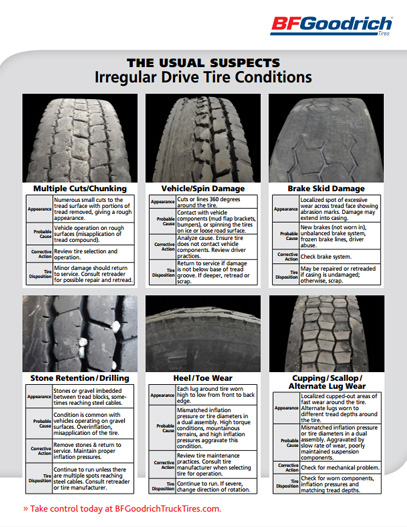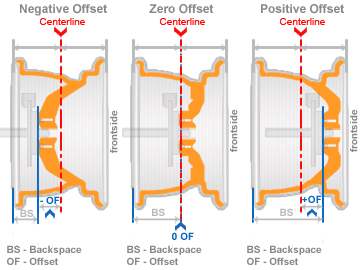Tire and Wheel Tech Tips
Tire Tech Tips
When should a tire be replaced?
A tire should be replaced once you have 1/8 of an inch above the tread bar. The tread bar is a raised bump that you see between the tread that is used as a wear indicator.

What causes tires to wear quickly?
Most causes of premature tire wear are related to misalignment of the tires. Always check your alignment every six months to ensure proper tire wear and get the most out of your tires. Other causes could be improper tire pressure or even damaged suspension.
When is a tire alignment required?
Misalignment will cause uneven tire wear that will result in high or low spots on the tire surface. It may also cause excessive wear on one part of the tire surface. To check for high and low spots, simply run your hand over the tire’s surface. See the image for reference.

Why does my Tire Pressure Indicator light keep coming on?
If your tire pressure light is on you could have the following problems:
- A punctured tire
- A cracked rim
- A leaky valve
- Tire is no longer sealing to the rim bead
- Dead sensor battery
- Tire pressure changed due to temperature fluctiations
What should I do if I hit a pot hole?
If you hit a pot hole always inspect your tire for damage such as tears or bulges. You may have a bent rim so that should also be checked.
How did I get a bulge on the side of my tire?
A bulge on the side of a tire is due to the metal cords in the sidewall of the tire separating. This causes the lining of the tire to thin while forcing the air out. Most consumer’s attribute this to a tire defect which is extremely rare but is mainly caused from an impact.
How do I choose the correct tire size for my car?
On the inside of your driver side door there is an information sticker that indicates the original manufacturer tire size. However there are other substitution sizes that will also work. Have a look at our substitution table when using our Vehicle Search Tool to see which substitution sizes work for your vehicle.
Wheel Tech Tips
What should I do if I bend a rim?
If you bend a rim it should be replaced. In order to fix a bent rim heat needs to be applied to it in order to straighten it back into position. When this happens you also weaken the rim making it easier to bend in the future.
How do I find the bolt pattern of the wheels for my vehicle?
Wheelsforless.ca has an excellent vehicle search tool. Simply enter your Make, Year and Model under Packages or Wheels and the search results will populate your fitment.
How do I measure my bolt pattern?
Bolt pattern is usually measured in millimeters. If you were to draw a circle through the center of your bolt pattern and measure across that would give you your bolt pattern (also known as PCD) measurement. Use our Vehicle Make and Model Search Tool to automatically populate wheels with the correct bolt pattern for your vehicle. The results will also display the bolt pattern and other specifications.
How do I measure for wheel Offset and Backspacing?
Offset is usually measured in millimeters. If you were to draw a line through the middle of your wheel and measure from that line to the mounting pad of your wheel, that would give you your Offset measurement. Backspacing is measured from the rear lip of the wheel to the mounting pad. Refer to the image below for reference.

What is the X-Factor of a wheel?
X-Factor is the amount of clearance that is available behind the spoke for proper brake caliper clearance.

What are hub-centric rims?
Hub-centric rims are rims with the center bore being the same size as the hub on your vehicle’s spindle for an exact fit. Hub centric wheels do not require hub centric rings.
When do I need hub centric rings?
Hub-centric rings are typically used for aftermarket wheels where the center bore of the wheel is larger than the hub on the spindle. The purpose is to center the wheel to the spindle for proper installation. You may experience vibration without them.
How are automotive wheels made?
Wheels are made from molten liquid aluminum that is injected into a mold under pressure. Once it has cooled, it is separated from the mold resulting in a casted wheel.
What are Forged Wheels?
Forged Wheels are very high quality wheels made from 6061-T6 aluminum which is pressed hot in a 10,000 ton forging press. Once forged, they are machined to precision using state of the art CNC technology resulting in a custom design and perfectly round wheel. These wheels are typically produced for exotic vehicles and have a much higher price point.



